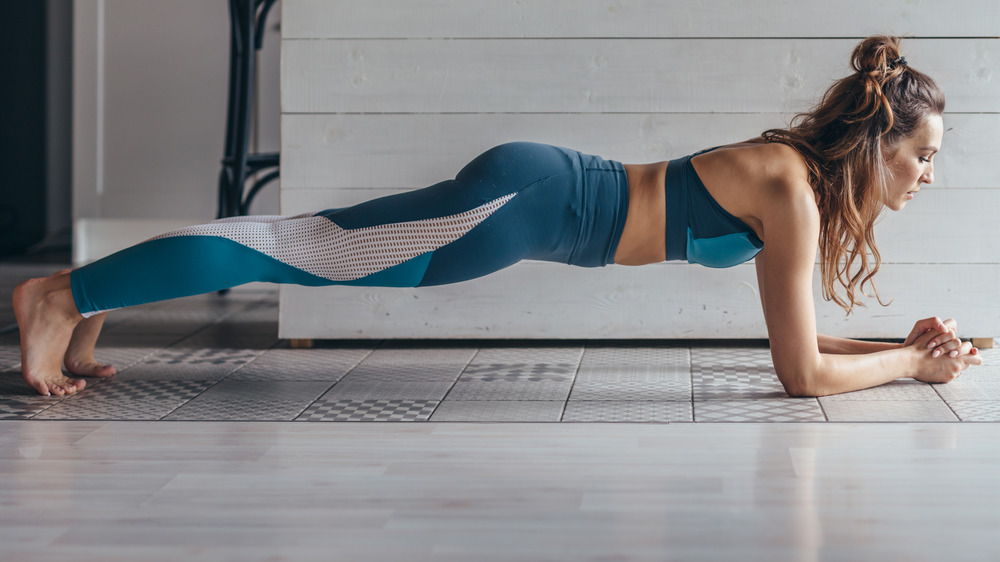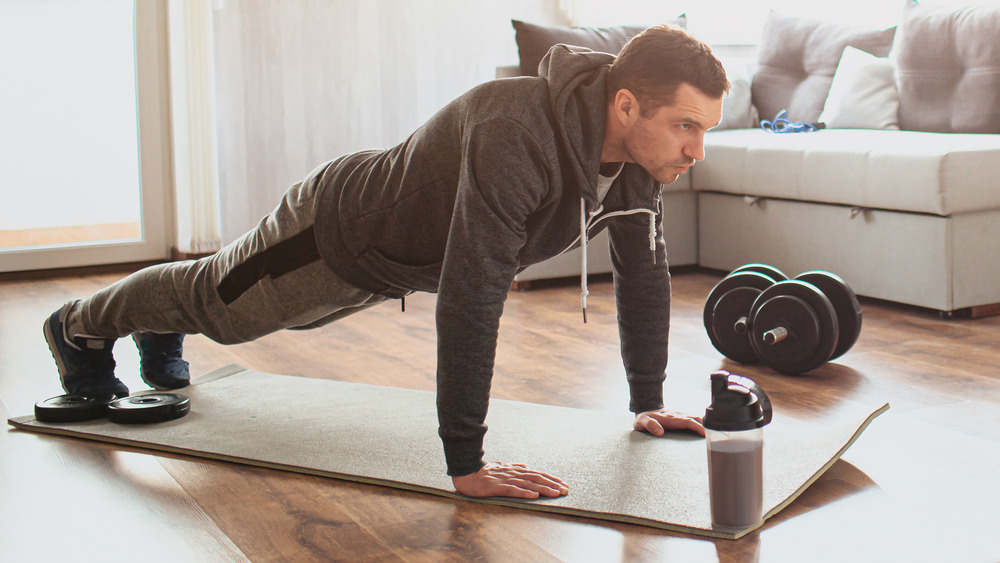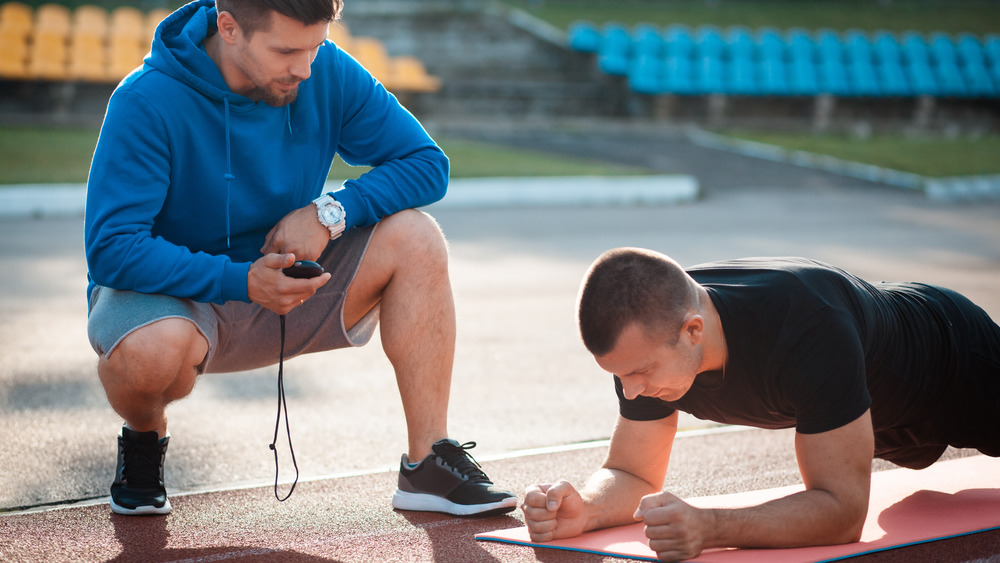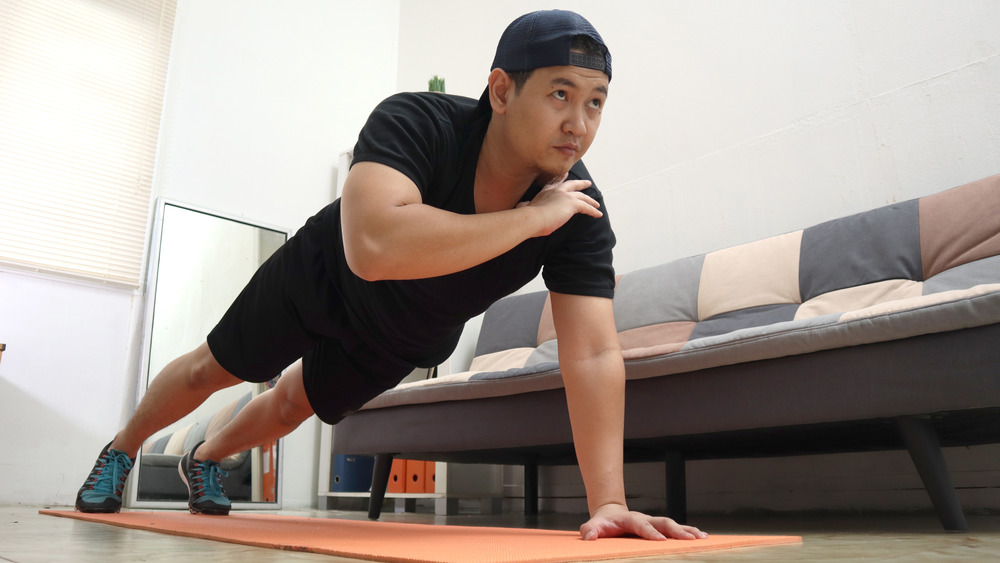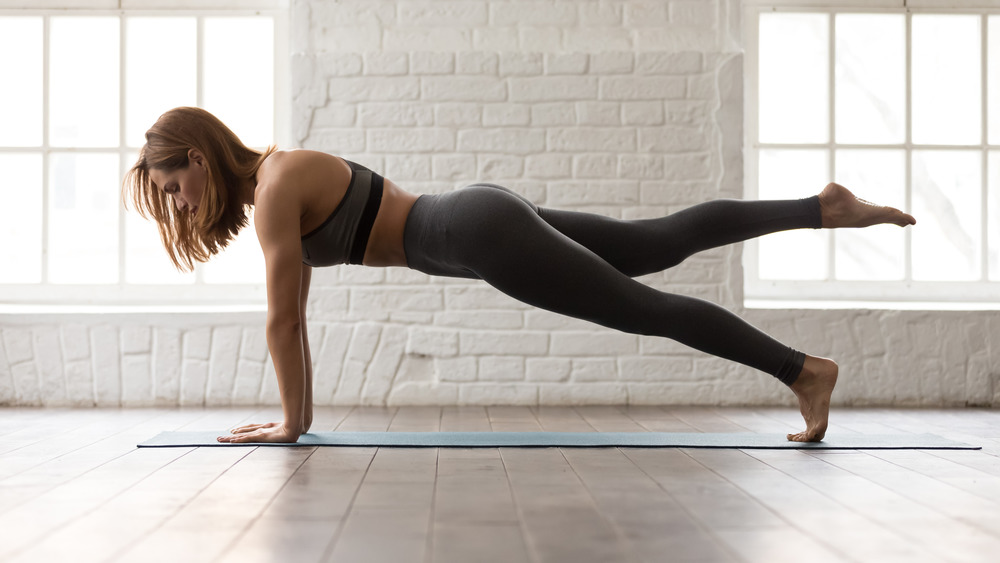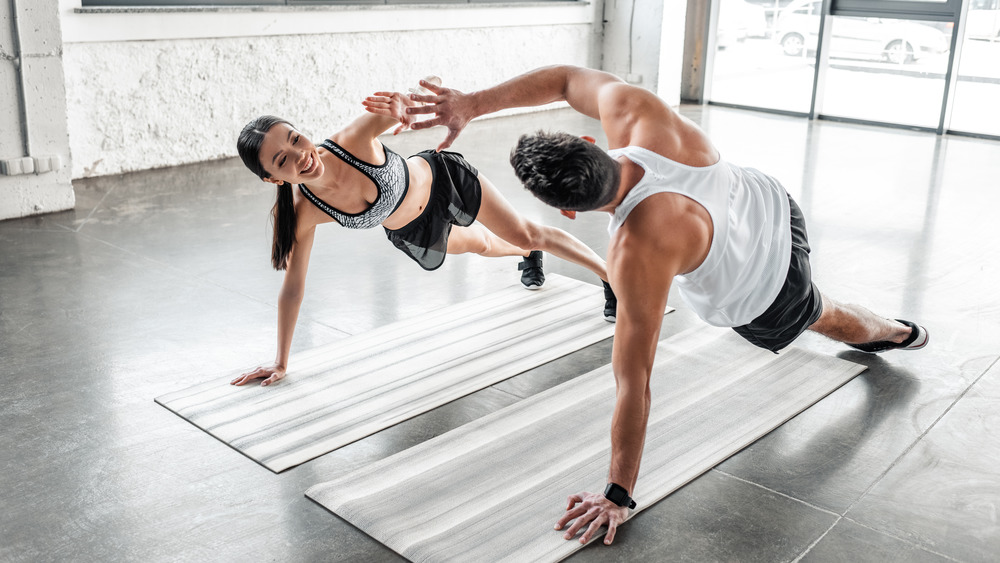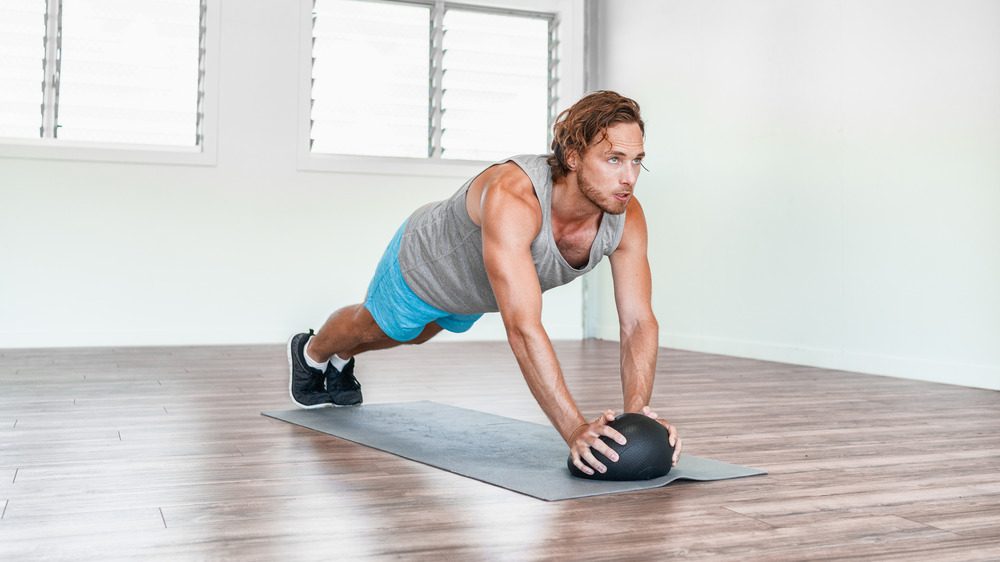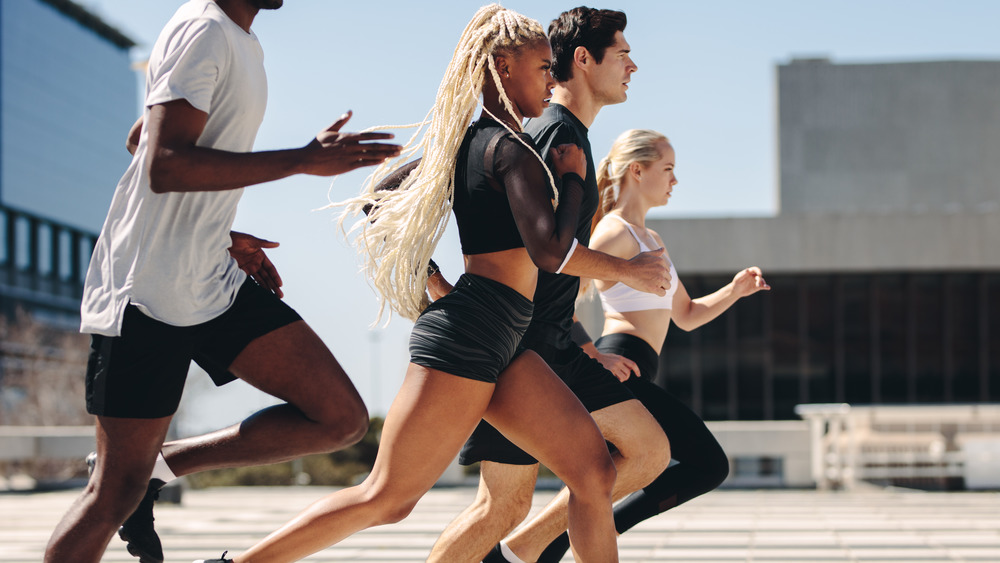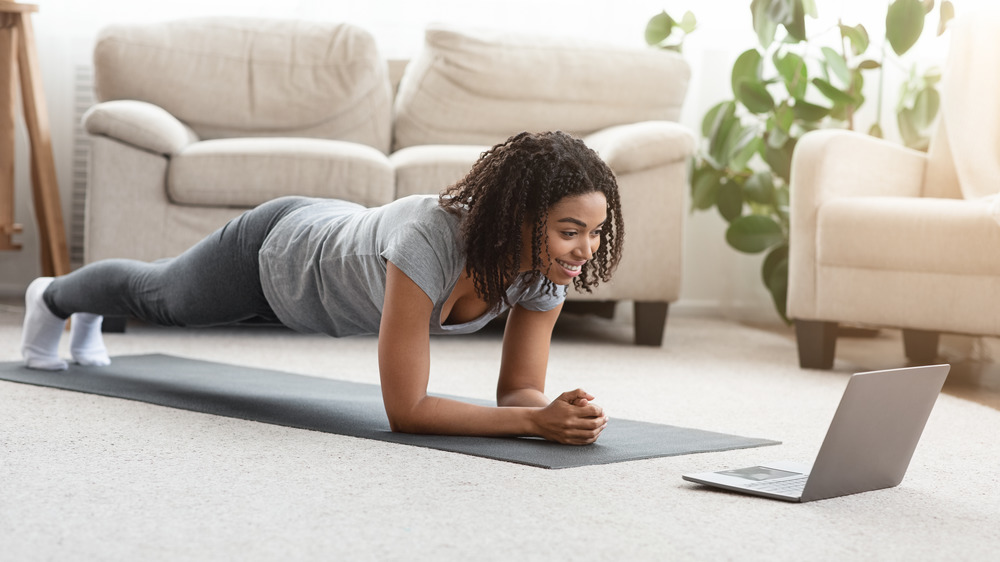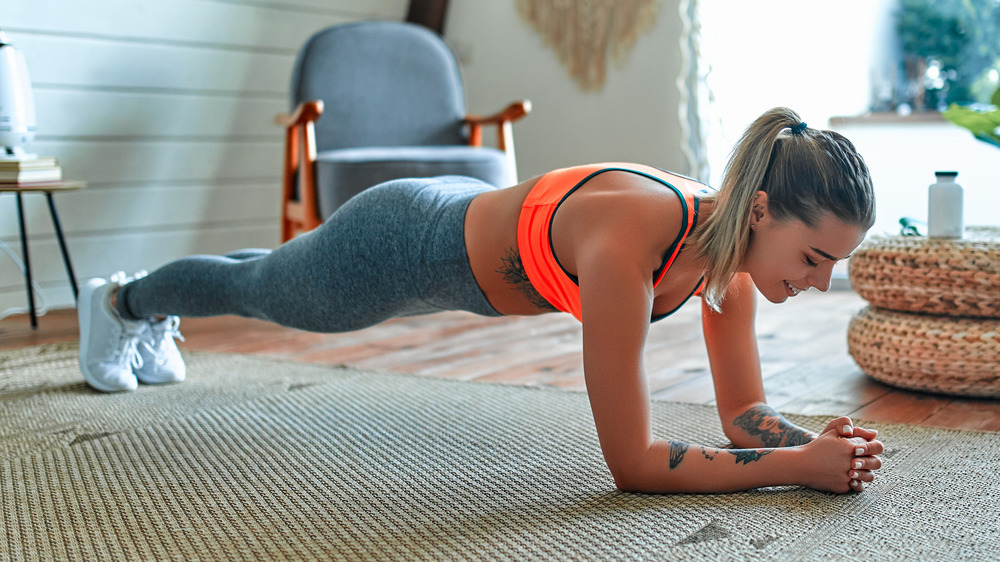When You Plank Every Day, This Is What Really Happens
The plank, a popular ab exercise, has roots as far back as the 1920s when Joseph Pilates introduced the leg pull front to his base of followers. However, the plank's true rise to fame as a go-to core-strengthening movement didn't really gain steam until the early 2000s. By 2014, major national fitness organizations, like the American Council on Exercise, were singing the plank's praises as a legitimate ab-strengthening replacement for crunches and sit-ups. So of course, with the exercise's popularity also came corresponding challenges, like the 30-day plank challenge.
The basic goal of his challenge is to perform a plank (with good form) every day for 30 days, with the goal of being able to hold a plank for two minutes by day 12, and five minutes by day 30. It's a solid way to monitor strength and stamina gains of a single exercise over the course of a month. And it certainly sounds doable, right? You just dedicate a maximum of five minutes of work daily over the course of a month. But when you decide to participate in this type of challenge, what can you expect to accomplish? Results vary from person to person, but here's what you might expect to experience once you start doing planks every day.
You'll benefit from reduced lower back pain when you plank every day
Even seemingly simple exercises like planks can cause pain if you're not doing them correctly. But the good news is: When you do a plank right, not only can you prevent injury, you may actually experience reduced incidences of lower back pain.
According to the American Council on Exercise, the plank is an excellent exercise to manage back pain because it contracts all the major muscle groups of the core without requiring much movement, strengthening the deep abdominal muscles to help stabilize the spine. So how do you know you're doing a plank correctly? Check your form.
The goal is to form a straight line from your heels to your head. Your elbows should be positioned directly beneath your shoulders, your upper back and shoulders engaged, preventing your chest from sinking between your arms or crunching your shoulders toward your ears. You should also engage your quads and glutes, tucking your pelvis under as you "pull" your belly button toward your spine, preventing your low back from caving toward the floor. Then, hold the position as long as you can without compromising proper form.
Planking every day will lead to deep ab muscle strength
When most people think of ab exercises, they think of exercises to strengthen the "six pack" muscles, or the rectus abdominis. But these "show me" muscles are just one of a set of abdominal muscles that also include the internal and external obliques (the muscles that wrap around your abdomen and help with trunk flexion, compression, and rotation) and the deep transverse abdominis (TVA).
Unlike some other ab exercises, the plank requires contraction of all four sets of muscle groups, but is particularly good at targeting the TVA. According to Verywell Fit, this deep muscle is particularly important because it acts like a "corset" to flatten the abdominal wall, support the internal organs, and to stabilize the lumbar spine, especially when doing movements that involve the arms and legs.
To activate the TVA, you can use bracing — contracting the abdominal muscles without moving, as though you were waiting to be punched in the stomach — or hollowing — contracting your abdomen while trying to "pull" your belly button toward your spine. Interestingly, planks — when done correctly — use both bracing and hollowing, effectively strengthening this important, oft-neglected, muscle group.
You'll see total core strength improvement when you plank every day
Planks work out all the muscles of your core. While many people think of the "core" as solely the muscles of the abdomen, the core is much more complex than that, encompassing everything from the hips to the shoulders. This includes the four primary muscle groups of the abdomen — the rectus abdominis, internal obliques, external obliques, and the transverse abdominis — and also the upper back, lower back, chest, shoulders, quads, glutes, and calves.
All of these muscles must contract and work in conjunction to hold your body in place and maintain proper form. The result is enhanced core strength that can help you in your day-to-day life as well as other athletic endeavors. This is even more noticeable when you expand your plank routines beyond the basic forearm plank and incorporate other plank variations to mix things up and target your core from different angles.
You'll enjoy enhanced isometric strength when you do planks every day
One thing to keep in mind about the basic plank exercise is that it's an isometric, or static, exercise. Unlike many other traditional exercises, like pull-ups, pushups, squats, or even crunches, which are considered isotonic exercises, the plank and other isometric exercises involve muscle contraction without movement. All of the muscle groups involved contract and hold at a very specific joint angle or body position.
As explained by personal trainer and writer Amy Marturana Winderl in an article for Self, isometric exercises can help build strength, but they're less effective at helping you grow muscle because your muscles aren't moving and experiencing the muscle damage associated with isotonic exercises. That said, they help teach your brain to recruit more muscle fibers for a given isometric action and they can help develop muscular endurance, or the ability to perform a certain movement for a longer length of time, exercise physiologist Mike T. Nelson told the publication. Planks will also help you develop strength and stability in the other muscles and joints, including the shoulders, hips, glutes, arms, and quads.
Doing planks every day could improve your overall athletic performance
The thing you have to remember about the muscular system is that it all works together. This is referred to as the kinetic chain. Even isolation exercises, like a biceps curl or triceps kickback, require recruitment and stabilization of the core muscles to help isolate the targeted muscle group. But one of the primary functions of the core is to help the upper body and lower body work in coordinated actions.
Think about it: Something as simple as walking, which requires coordinated arm and leg swings that are connected through the muscles of the core, is actually quite complex when you take into account all of the muscles being used. When planks are performed on a regular basis, athletic performance may even improve because your body learns how to efficiently recruit core muscles for stabilization and the transfer of energy between upper and lower body," Rozalynn Frazier, a NASM-certified trainer, explained in an article for Livestrong. This helps improve body awareness, stability, and coordination, all of which play an important role in athletic performance.
Your shoulder stability will improve when you do planks every day
The shoulder joint is pretty amazing. It's the most flexible joint in the body, capable of rotation, flexion, extension, and both abduction and adduction in two planes of motions. The result is an incredible range of motion that allows for all sorts of movements that make day-to-day life easier. Of course, there's a downside to all that movement and range of motion. The shoulder is also the least stable joint in the body. This makes it particularly susceptible to injury and dislocation.
One effective way to help improve stability and strength at the shoulder is to perform planks on a regular basis. As pointed out by Stack, the plank's isometric hold engages and builds strength around the shoulder blade and at the rotator cuff to keep these smaller muscles stable when performing other exercises. This helps enhance the activation of shoulder muscles during exercise, ultimately reducing injury risk — particularly if you tend to play sports that require swinging or throwing or if you tend to lift heavy weights.
Planking every day will improve your posture
If your mom still nags you to stand up straight or pull your shoulders back, it might be time to start incorporating planks into your daily routine. This is especially true if you work a desk job in which you're constantly rounding your back, shoulders, and neck while sitting in front of a computer all day.
You see, proper plank form is more or less perfect posture. Even though planks are performed in a horizontal position, the idea is the same — you're contracting your core, engaging your lumbar spine and glutes to prevent your low back from caving, and pulling your shoulder blades down and in toward the spine to prevent your neck from collapsing between your arms. If someone were to draw a line from your ears to your shoulders, hips, knees, and ankles, it should form a completely straight line.
As Rozalynn Frazier, a NASM-certified trainer, explained in an article for Livestrong, the plank exercise teaches your muscles and joints to "stack" your spine in proper alignment, developing strength and recruiting the proper muscles for good posture. This ultimately transfers from the plank's horizontal position to proper posture when you're sitting, standing, walking, or running.
When you plank every day, you'll have better balance
A strong core can improve balance and help prevent falls, as pointed out by Harvard Health. When your core muscles are efficient and strong, your lower body joints and muscles are more capable of making quick corrections to sudden changes in body position.
To put it another way: If you're walking down the street and someone bumps into you from behind, a strong core will be able to contract and engage efficiently, helping prevent your spine from flexing or rotating awkwardly while simultaneously helping the muscles of your legs respond in a way that allows you to catch your balance.
This quick and efficient core engagement is essential for balance and can be enhanced with plank exercises. Health suggests using a plank reach — a variation in which you lift opposite hands and feet of the ground while holding a stable core — to further develop balance and coordination. But if you're not ready for this variation just yet, start with a standard plank, then try lifting one limb at a time for a second or two. Even small challenges like this can further build balance and stability.
You may have the ability to lift heavier weights when you plank every day
Planks can help you lift heavier weights in two ways. First, because planks help develop strength of the "corset" muscle — the transverse abdominis — and develop strength around the stabilizers of the spine, exercises that require core engagement and a stable spine (think: heavy squats or dumbbell shoulder presses) may become easier as your core strength improves. Second, the plank itself is a position that can help build baseline strength at the shoulders, hips, glutes, and core for other popular exercises.
Rozalynn Frazier, a NASM-certified trainer, explained in an article for Livestrong that it's a good idea to consider the plank a "foundational move, one that builds your strength from the ground up." When your plank feels strong and steady, you can easily start branching out to plank-adjacent moves, such as pushups, renegade rows, mountain climbers, and kettlebell swings, all of which essentially incorporate plank form into more dynamic exercises.
Planking every day will boost your metabolism (a little bit)
When it comes to metabolism-boosting exercises, the plank isn't at the top of the list. Typically, you need to focus on dynamic movements, such as burpees, jump rope, squat presses, or mountain climbers if you really want to get your internal fires burning those extra calories. That said, performing a daily plank challenge certainly won't hurt your metabolism, and it can give you at least a little boost — especially if you're focused on engaging all your major muscle groups to perform the plank.
Andia Winslow, master certified fitness professional and pro athlete, shared with Livestrong, "Anytime prime movers (legs and glutes) are involved, there will be greater caloric burn, which is why, in a plank, folks have to remember to engage their legs, squeezing the thighs and glutes along with holding the core and trunk firm." And once you've mastered the standard plank, incorporating dynamic planks into your routine can further help you engage more muscle groups and burn more calories.
Planking every day will improve your running time
Running is a perfect example of an exercise in which a strong core and efficient transfer of power between the upper and lower halves is particularly important. When running, you need your shoulders to engage to create an efficient arm swing, and the arm swing needs to be coordinated with your leg swing, which originates from the hips. And what connects the shoulders and the hips? All the muscles of your core.
As Stuart McGill, a spine health and core training expert, pointed out in an interview with Runner's World, planks help develop the strength that allows for trunk stiffness during running, and this stiffness can help your legs move. When your core is braced, your spine is stable, and you're able to efficiently recruit the right combination of muscles at the right time. As such, it's practically guaranteed that your running will improve.
McGill explained that you don't need to spend an outrageous amount of time planking to see such results. "Research shows that for most people, holding a plank for one minute at a time creates a resilient torso," he revealed. "But if you have a history of back pain, hold for 10 second increments to reduce your risk of back pain triggers."
Doing planks every day may just boost your self-esteem
If you're looking for a way to beat back the blues or to feel better about yourself, never underestimate the power of strength training. While most people think of strength training as a full-fledged weight room routine (which it certainly can be), it's important to remember that a daily plank session also counts as one simple form of strength training. While it may not reap the same level of results as a more robust workout, it's great for times when you're short on energy or motivation — and it may be all you need for a mental health boost (and perhaps, all you're able to handle).
In a summary review of the mental health benefits of resistance training, Dr. Len Kravitz and Amenda Ramirez of the University of New Mexico pointed out that resistance training can improve self-esteem, combat anxiety, boost cognition, lessen depression, improve sleep, and enhance memory. Not to mention, performing an exercise every single day can help you develop the self-efficacy and confidence you need to gradually expand the program and incorporate different exercises.
Your stomach might feel flatter after doing planks every day, but that's not a guarantee
It's a fair assumption that many people start incorporating ab exercises like planks into their daily routines in order to help carve a more svelte, flat stomach. However, ab exercises and planks alone may not result in the whittled middle you're looking for. That's not to say you won't see any results, though. As one 30-day plank challenger recounted to Insider, she felt like her stomach was flatter by the end of the 30 days than it was at the start.
This may be due to better posture or enhanced core muscle engagement, but planks alone are unlikely to boost metabolism so greatly as to help you experience a significant weight loss after 30 days. And as the planker noted, "As expected, I didn't suddenly have more defined abs or anything."
If you're looking to flatten your belly, you'll need to approach the goal from all angles, including making changes to your diet and adding full-body strength exercises and cardio to boost your metabolism. If you're doing all of these things? Planks can certainly help you achieve the abdominal muscle tone you're after.

